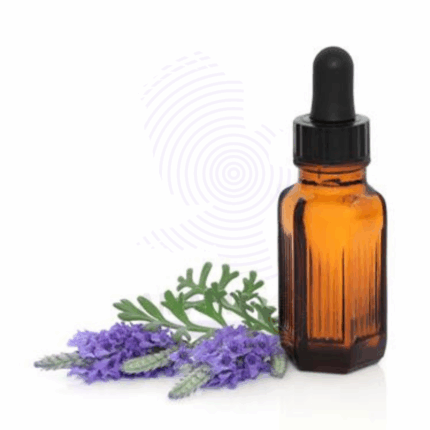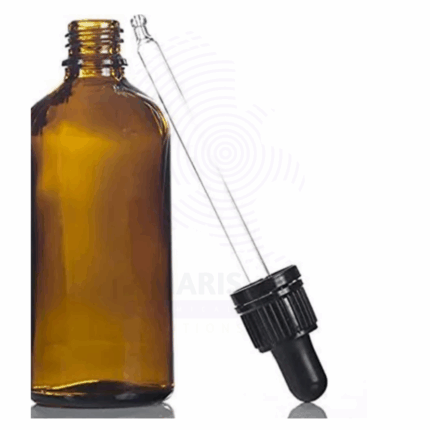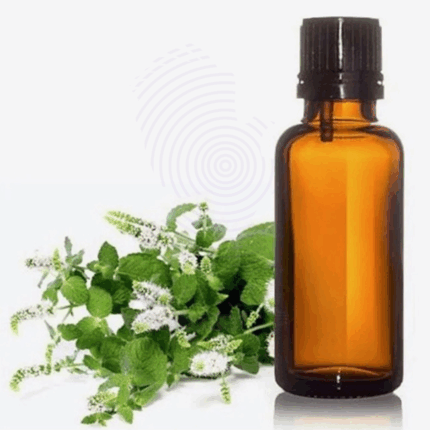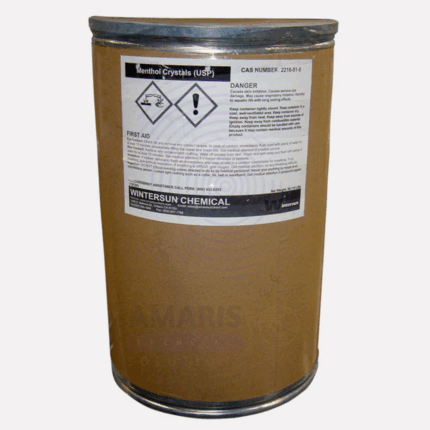Ethylvanillin
Whatsapp Order
Ethylvanillin (3-Ethoxy-4-hydroxybenzaldehyde) is a synthetic aromatic aldehyde widely used as a flavoring agent and fragrance ingredient. It is a white to pale yellow crystalline powder with a strong, sweet vanilla-like odor, but more intense than natural vanillin. Ethylvanillin offers excellent flavor stability, solubility in alcohol and oils, and is valued for its enhanced vanilla aroma in food, beverage, cosmetics, and pharmaceutical formulations. Due to its potent scent and flavor profile, it is a preferred substitute or complement to natural vanilla extract.
Description
Ethylvanillin Uses
Table of Contents
Toggle
Primary Uses
- Food & Beverage Industry
- Used as a flavor enhancer in bakery products, confectionery, chocolates, dairy items, and beverages to impart a rich vanilla aroma.
- Employed in flavor formulations for ice creams, puddings, syrups, and soft drinks.
- Acts as a masking agent to cover undesirable odors and enhance overall sensory profiles.
- Fragrance & Perfumery
- Incorporated in perfumes, colognes, and scented products for its sweet, creamy, and long-lasting vanilla scent.
- Used in soaps, lotions, deodorants, and personal care products to provide warm vanilla notes.
- Utilized in aromatherapy blends and scented candles.
- Pharmaceuticals
- Added as a flavoring agent in syrups, lozenges, chewable tablets, and oral medications to improve palatability and patient compliance.
- Sometimes used in topical formulations for its pleasant aroma.
- Cosmetics & Personal Care
- Used in lip balms, creams, body lotions, and hair care products for fragrance enhancement.
- Functions as a scent modifier or base note in complex fragrance compositions.
Secondary Uses
- Food Packaging & Processing
- Employed as an additive in packaging materials to impart vanilla scent or mask packaging odors.
- Used in aroma release systems and controlled flavor delivery mechanisms.
- Household Products
- Incorporated in air fresheners, fabric softeners, and cleaning agents for a sweet vanilla fragrance.
- Tobacco Industry
- Added as a flavor additive in tobacco products and e-liquids to create vanilla flavor variants.
- Chemical Intermediate
- Used in organic synthesis for derivatives and specialty chemicals requiring aromatic aldehyde functionality.
PRODUCT KEY FEATURES
- Basic Identification Attributes
- Chemical Name (IUPAC): 3-Ethoxy-4-hydroxybenzaldehyde
- Common/Trade Name: Ethylvanillin
- CAS Number: 121-32-4
- HS Code: 2914.39.00
- Molecular Formula: C9H10O3
- Synonyms: Ethyl vanillin, Vanillin ethyl ether, 3-Ethoxy-4-hydroxybenzaldehyde
- Physical & Chemical Properties
- Physical State: Crystalline powder
- Color: White to pale yellow
- Odor: Strong sweet vanilla aroma
- Melting Point: 77–79°C
- Boiling Point: 297°C (decomposes)
- Density: ~1.23 g/cm³
- Solubility: Soluble in alcohol, oils, and organic solvents; sparingly soluble in water
- Stability: Stable under normal conditions; sensitive to strong acids and bases
- Safety & Hazard Attributes
- Hazard Class (GHS): Not classified as hazardous but may cause mild skin or eye irritation
- Toxicity: Low acute toxicity; ingestion in large amounts not advised
- Exposure Limits: No specific occupational exposure limits established
- Storage & Handling Attributes
- Storage Conditions: Store in a cool, dry, well-ventilated area away from light and moisture
- Container Type: Sealed glass or plastic containers, moisture-proof packaging
- Shelf Life: 24 months if stored properly
- Handling Precautions: Avoid dust formation, minimize inhalation, and prevent eye contact
- Regulatory & Compliance Attributes
- FDA Status: Generally recognized as safe (GRAS) for use as a flavoring agent
- EFSA Approval: Approved as a flavoring substance in the EU
- Compliance: Meets food-grade specifications and purity standards
- Usage Restrictions: Used within regulated concentration limits in food and cosmetics
- Environmental & Health Impact
- Biodegradability: Readily biodegradable
- Ecotoxicity: Low toxicity to aquatic organisms
- Bioaccumulation: Not expected
- Carcinogenicity/Mutagenicity: Not classified as carcinogenic or mutagenic
SAFETY HANDLING PRECAUTIONS
Safety Handling Precautions
- Personal Protective Equipment (PPE):
- Gloves (nitrile or latex)
- Safety goggles
- Dust mask or respirator in dusty environments
- Lab coat or protective clothing
- Handling Guidelines:
- Use in well-ventilated areas
- Avoid dust inhalation and contact with skin and eyes
- Prevent dust accumulation and spills
- Storage Measures:
- Keep containers tightly sealed
- Protect from moisture, light, and heat
- Store away from incompatible substances (strong oxidizers)
- Hygiene Practices:
- Wash hands after handling
- Avoid eating, drinking, or smoking near handling areas
- Clean surfaces and equipment after use
First Aid Measures
- Inhalation:
- Move to fresh air; seek medical attention if breathing difficulties or irritation occur
- Skin Contact:
- Wash with soap and water; seek medical advice if irritation develops
- Eye Contact:
- Rinse eyes thoroughly with water for 15 minutes; consult physician if irritation persists
- Ingestion:
- Rinse mouth; do not induce vomiting; seek immediate medical help if large quantities ingested
Firefighting Measures
- Fire Hazards:
- Combustible solid; emits toxic fumes upon burning
- Extinguishing Media:
- Use dry chemical, foam, carbon dioxide (CO₂), or water spray
- Special Precautions:
- Firefighters should wear protective gear and self-contained breathing apparatus if necessary
- Decomposition Products:
- Carbon monoxide, carbon dioxide, and aromatic aldehyde fragments
Related products
Abies Alba oil
Abies Alba Oil, also known as Silver Fir Needle Oil, is a high-purity essential oil extracted via steam distillation from the needles and twigs of the European Silver Fir (Abies alba). Native to the alpine forests of Europe, this oil is prized for its crisp, forest-fresh aroma and therapeutic versatility. Rich in naturally occurring monoterpenes such as alpha-pinene and bornyl acetate, Abies Alba Oil possesses purifying, anti-inflammatory, and antimicrobial qualities.
Its clean, invigorating scent supports respiratory wellness, emotional balance, and mental clarity, making it a popular ingredient in aromatherapy and spa products. It is also used extensively in cosmetic formulations for its deodorizing, skin-soothing, and aromatic effects. Abies Alba Oil is a natural solution for enhancing wellness and sensory experiences across multiple industries.
Basil Exotic oil
Basil Exotic Oil is a steam-distilled essential oil extracted from the leaves of the Ocimum basilicum plant, specifically cultivated for its high linalool and methyl chavicol (estragole) content. Known for its sweet, herbaceous, and slightly spicy aroma, Basil Exotic Oil offers powerful aromatic and therapeutic properties. It is widely used in perfumery, cosmetics, personal care products, and aromatherapy for its stimulating, clarifying, and refreshing effects.
The oil’s high potency and distinctive scent make it a preferred choice in high-end fragrances, hair care products, and massage blends. It is also appreciated for its antibacterial, antifungal, and anti-inflammatory characteristics, making it valuable in natural wellness and skincare formulations.
Cajaput Oil
Cajaput Oil is a clear, penetrating essential oil obtained via steam distillation of the fresh leaves and twigs of the Melaleuca cajuputi or Melaleuca leucadendra tree, primarily native to Southeast Asia. With its strong, camphoraceous, and slightly fruity aroma, Cajeput Oil is known for its powerful antiseptic, analgesic, and expectorant properties. Rich in 1,8-cineole (eucalyptol), this oil has been traditionally used in topical rubs, respiratory blends, and muscle-relieving formulations.
Cajeput Oil is widely used in cosmetics, personal care, aromatherapy, and natural medicine products for its invigorating and purifying effects on both skin and the respiratory system. It is often compared to tea tree and eucalyptus oils due to its similar therapeutic actions.
Isopropyl Myristate
Isopropyl Myristate is a clear, colorless, and oily liquid ester formed by the reaction of isopropyl alcohol and myristic acid. It has a mild, pleasant odor and excellent spreading properties. IPM is widely used in cosmetics, pharmaceuticals, and industrial applications as an emollient, solvent, and penetration enhancer due to its ability to improve texture and absorption of topical formulations.
Isopropyl Palmitate
Isopropyl Palmitate IPP is a clear, colorless to pale yellow oily liquid formed by the esterification of isopropyl alcohol and palmitic acid. It has a mild odor and is widely used in cosmetic, pharmaceutical, and industrial formulations as an emollient, lubricant, and solvent. IPP is valued for its excellent skin absorption, non-greasy feel, and ability to improve texture and spreadability of topical products.
Menthol crystals
Menthol Crystals are natural organic compounds derived from peppermint or other mint oils, presenting as clear or white crystalline solids with a strong, cooling mint aroma. They possess analgesic, antiseptic, and flavoring properties. Widely used in pharmaceuticals, cosmetics, food, and personal care products, menthol crystals provide a refreshing cooling sensation and fragrance, enhancing product efficacy and consumer appeal.
Methyl Salicylate BP
Methyl Salicylate BP is a clear, colorless to pale yellow oily liquid with a characteristic strong, sweet, and minty odor. It is an organic ester commonly used for its analgesic, anti-inflammatory, and flavoring properties. Methyl Salicylate is widely used in pharmaceutical preparations, topical pain relief products, cosmetics, and as a fragrance ingredient.
Natural Sweet Potatoes Extract
Natural Sweet Potatoes Extract is a concentrated substance derived from the roots of sweet potatoes (Ipomoea batatas) through processes such as solvent extraction, freeze-drying, or spray drying. Rich in antioxidants, vitamins (especially vitamin A and C), minerals, and natural pigments like beta-carotene and anthocyanins, this extract is valued for its nutritional benefits and vibrant natural color. It is widely used in food, beverage, nutraceutical, cosmetic, and pharmaceutical applications for its health-promoting and coloring properties.


 Preservatives(food)
Preservatives(food) Flavor Enhancers
Flavor Enhancers Acidulants
Acidulants Sweeteners
Sweeteners Antioxidants
Antioxidants Colorants(food)
Colorants(food) Nutraceutical Ingredients (food)
Nutraceutical Ingredients (food) Nutrient Supplements
Nutrient Supplements Emulsifiers
Emulsifiers
 Collectors
Collectors Dust Suppressants
Dust Suppressants Explosives and Blasting Agents
Explosives and Blasting Agents Flocculants and Coagulants
Flocculants and Coagulants Frothers
Frothers Leaching Agents
Leaching Agents pH Modifiers
pH Modifiers Precious Metal Extraction Agents
Precious Metal Extraction Agents
 Antioxidants(plastic)
Antioxidants(plastic) Colorants (Pigments, Dyes)
Colorants (Pigments, Dyes) Fillers and Reinforcements
Fillers and Reinforcements Flame Retardants
Flame Retardants Monomers
Monomers Plasticizers
Plasticizers Polymerization Initiators
Polymerization Initiators Stabilizers (UV, Heat)
Stabilizers (UV, Heat)
 Antifoaming Agents
Antifoaming Agents Chelating Agents
Chelating Agents Coagulants and Flocculants
Coagulants and Flocculants Corrosion Inhibitors
Corrosion Inhibitors Disinfectants and Biocides
Disinfectants and Biocides Oxidizing Agents
Oxidizing Agents pH Adjusters
pH Adjusters Scale Inhibitors( water)
Scale Inhibitors( water)
 Antioxidants(cosmetic)
Antioxidants(cosmetic) Emollients
Emollients Fragrances and Essential Oils
Fragrances and Essential Oils Humectants
Humectants Preservatives
Preservatives Surfactants(cosmetic)
Surfactants(cosmetic) Thickeners
Thickeners UV Filters
UV Filters
 Fertilizers
Fertilizers Soil Conditioners
Soil Conditioners Plant Growth Regulators
Plant Growth Regulators Animal Feed Additives
Animal Feed Additives Biostimulants
Biostimulants Pesticides (Herbicides, Insecticides, Fungicides)
Pesticides (Herbicides, Insecticides, Fungicides)
 Active Pharmaceutical Ingredients (APIs)
Active Pharmaceutical Ingredients (APIs) Excipients
Excipients Solvents(pharmaceutical)
Solvents(pharmaceutical) Antibiotics
Antibiotics Antiseptics and Disinfectants
Antiseptics and Disinfectants Vaccine Adjuvants
Vaccine Adjuvants Nutraceutical Ingredients (pharmaceutical)
Nutraceutical Ingredients (pharmaceutical) Analgesics & Antipyretics
Analgesics & Antipyretics
 Analytical Reagents
Analytical Reagents Solvents(lab)
Solvents(lab) Chromatography Chemicals
Chromatography Chemicals Spectroscopy Reagents
Spectroscopy Reagents microbiology-and-cell-culture-reagents
microbiology-and-cell-culture-reagents Molecular Biology Reagents
Molecular Biology Reagents Biochemical Reagents
Biochemical Reagents Inorganic and Organic Standards
Inorganic and Organic Standards Laboratory Safety Chemicals
Laboratory Safety Chemicals Specialty Laboratory Chemicals(Special Laboratory Equipment)
Specialty Laboratory Chemicals(Special Laboratory Equipment)
 Demulsifiers
Demulsifiers Hydraulic Fracturing Fluids
Hydraulic Fracturing Fluids Scale Inhibitors(oil)
Scale Inhibitors(oil) Surfactants(oil)
Surfactants(oil) Drilling Fluids
Drilling Fluids
 Dyes and Pigments
Dyes and Pigments Bleaching Agents
Bleaching Agents Softening Agents
Softening Agents Finishing Agents
Finishing Agents Antistatic Agents
Antistatic Agents
 Admixtures
Admixtures Waterproofing Agents
Waterproofing Agents Sealants and Adhesives
Sealants and Adhesives Curing Compounds
Curing Compounds Concrete Repair Chemicals
Concrete Repair Chemicals Anti-Corrosion Coatings
Anti-Corrosion Coatings
 Surfactants(cleaning)
Surfactants(cleaning) Builders
Builders Enzymes
Enzymes Solvents (Cleaning)
Solvents (Cleaning) Fragrances
Fragrances
 Electronic Chemicals
Electronic Chemicals Catalysts
Catalysts Lubricants
Lubricants Photographic Chemicals
Photographic Chemicals Refrigerants
Refrigerants Automotive chemicals
Automotive chemicals Pyrotechnic Chemicals
Pyrotechnic Chemicals
 Biodegradable Surfactants
Biodegradable Surfactants Bio-based Solvents
Bio-based Solvents Renewable Polymers
Renewable Polymers Carbon Capture Chemicals
Carbon Capture Chemicals Wastewater Treatment Chemicals
Wastewater Treatment Chemicals
 Pigments
Pigments Solvents(paint)
Solvents(paint) Specialty Coatings
Specialty Coatings Binders/Resins
Binders/Resins Additives
Additives Driers
Driers Anti-Corrosion Agents
Anti-Corrosion Agents Functional Coatings
Functional Coatings Application-Specific Coatings
Application-Specific Coatings
 Fresh Herbs
Fresh Herbs Ground Spices
Ground Spices Whole Spices
Whole Spices Spice Blends
Spice Blends Dried Herbs
Dried Herbs
 Leavening Agents
Leavening Agents Dough Conditioners
Dough Conditioners Flour Treatments
Flour Treatments Fat Replacers
Fat Replacers Decoratives
Decoratives Preservatives(baking)
Preservatives(baking)
 Plasticizers & Softeners
Plasticizers & Softeners Reinforcing Agents
Reinforcing Agents Adhesion Promoters
Adhesion Promoters Vulcanizing Agents
Vulcanizing Agents Antidegradants
Antidegradants Blowing Agents
Blowing Agents Fillers & Extenders
Fillers & Extenders Accelerators & Retarders
Accelerators & Retarders



























